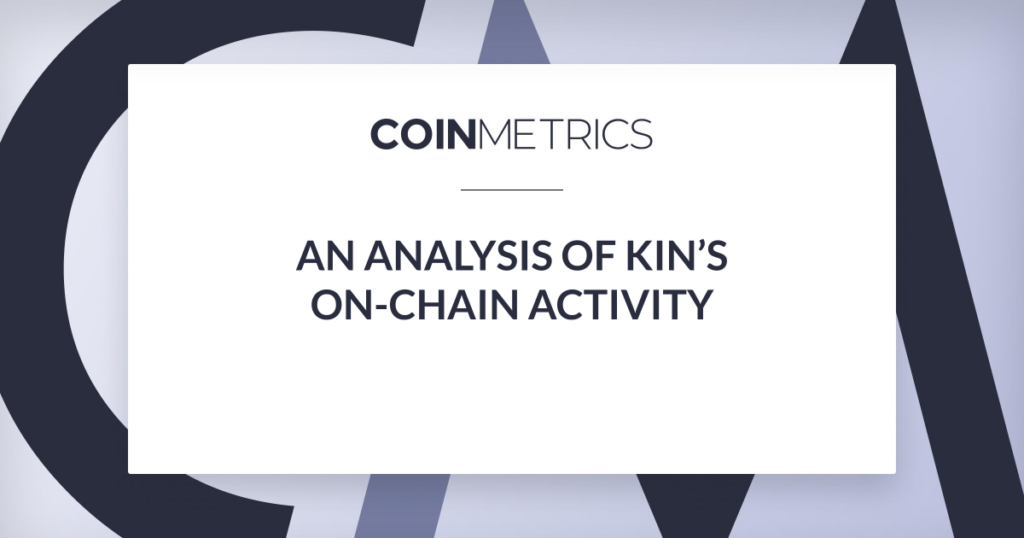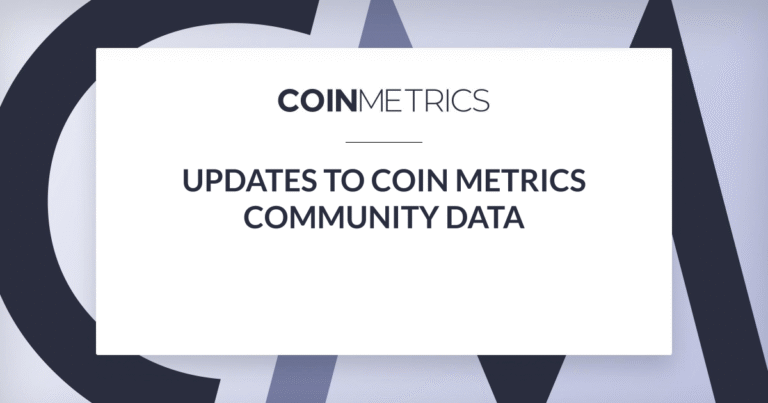In the following post, we investigate Kin’s on-chain activity compared to other blockchains.
The SEC has officially filed a lawsuit against Kik, the parent company of the Kin token, accusing them of selling unregistered securities. Kik has vowed to fight the suit, and recently launched a crowdfunding campaign to fund the effort.
As part of their response to the SEC, Kik made several claims about the usage of their blockchain, two of which are of particular note:
Claim 1: Activity
Consistent with Kik’s stated vision, Kin has been adopted, integrated, and used within over 30 digital applications. Excluding secondary market transactions, as of today, Kin exceeds Ether and Bitcoin in daily blockchain activity, demonstrating Kin’s wide acceptance and adoption. (See https://blocktivity.info/.) Indeed, of the over 2,000 tokens in circulation, Kin is ranked as having the fifth highest daily blockchain activity.
– Kik’s Response to the SEC Wells Notice
Claim 2: Users
Despite the fact that last month over 300,000 people earned and spent Kin as a currency, the SEC is still saying that it might be a security.
– Kik Responds To the SEC Complaint
Although the case is primarily about whether or not Kin’s Token Distribution Event should be considered an unregistered sale of a security, Kik’s response brings up another important question: how do we measure real blockchain activity and usage? And can Kin’s ledger, the ultimate source of truth for any blockchain, verify the claims Kik has made about Kin’s blockchain activity?
Methodology
In the following post, we investigate both of Kik’s claims about activity and usage by auditing the Kin Blockchain.
Kin has gone through several infrastructure changes over the past few years. Kin was first launched as an ERC20 token built on the Ethereum blockchain (Kin 1). It then moved to a two-chain hybrid solution built on a fork of Stellar, that still supported the Ethereum blockchain (Kin 2). Kin 2 is a centralized version of the Kin blockchain that was designed to be a temporary solution before moving to a self-described decentralized blockchain, Kin 3. Kin is now in the process of migrating to Kin 3, which is also forked from the Stellar protocol.
In order to analyze Kik’s claims about on-chain operations, we assessed on-chain data from both the Kin 2 and Kin 3 version of the ledger. Kin 1 (ERC20) is basically disused at this point (it currently has less than 500 daily transactions) as most tokens have been migrated over to Kin 2 or Kin 3, so we omitted it from our analysis.
Claim #1: Assessing Blockchain Activity
Consistent with Kik’s stated vision, Kin has been adopted, integrated, and used within over 30 digital applications. Excluding secondary market transactions, as of today, Kin exceeds Ether and Bitcoin in daily blockchain activity, demonstrating Kin’s wide acceptance and adoption. (See https://blocktivity.info/.) Indeed, of the over 2,000 tokens in circulation, Kin is ranked as having the fifth highest daily blockchain activity.
– Kik’s Response to the SEC Wells Notice
As it stands today, there are well-defined and accepted metrics for estimating usage and activity of traditional applications. Daily active users (DAU), for example, is a widely used and agreed-upon metric. But given their relative infancy, blockchains do not share this level of standardization. Even seemingly simple questions like ‘what counts as a blockchain user?’ and ‘what counts as activity?’ are still up for debate.
In the following section, we investigate Claim #1 according to two different criteria:
Operations Count: Firstly, we examine if Kin is a leader in blockchain activity as measured by operations count, which is the metric that Kik used as evidence for their claim.
Transfer Value: Next we investigate how Kin compares in a different measure of activity: transfer value. We define transfer value as the USD value of all native units transferred (i.e., the aggregate size in USD of all transfers) during that day.
Using Operations Count To Assess Claim #1
According to Kik’s source for the metric, ‘blockchain activity’ is defined as ‘the number of operations on the blockchain in the last 24 hours.’ Operations are broadly defined as any type of action that could be recorded on chain. But operations are not standardized across blockchains which makes comparing across chains difficult.
Additionally, different blockchains have different use cases. Kin is designed primarily to be used within the Kik messaging app to buy and sell digital content (e.g., stickers) and send payments directly to other users. Other blockchains, however, are designed for radically different purposes, which can make it difficult to compare operations across different platforms.
There are two distinct types of operations that happen on the Kin blockchain: payments and account creations. Payments are simply transfers of value (i.e. movement of Kin tokens) between two distinct addresses. Account creation operations on Kin create a local key pair and record the account creation on the Kin blockchain. On Kin 3, it is also possible to transfer Kin to an account while simultaneously creating it, which is then recorded on-chain. This differs from blockchains like Bitcoin and Ethereum, where keys are created locally but are not recorded on chain.
The below charts show the count of these two different types of operations on both Kin 2 and Kin 3. Over the last three months, 36% of Kin 2 operations and 72% of Kin 3 operations have been account creations:
In theory, Kin account creation could be a good proxy for blockchain activity: more Kin accounts could mean more users. But the Kin blockchain has another modification which adds more noise to this measurement: Kin accounts do not have a minimum required account balance, and therefore can remain empty indefinitely.
Stellar-based ledgers require a ‘base reserve’, which is a minimum amount of native units required for each address. This serves as a spam prevention mechanism to inhibit empty addresses from bloating the blockchain. For Stellar, this base reserve is 0.5 XLM (about $0.06 at current prices). Kin, however, does not have the same required minimum account balance. Kin initially implemented a base reserve value of 1,000 Kin but this was later changed to 0 Kin at ledger #5 (a ‘ledger’ is Kin’s version of a block).
The below chart shows Kin’s (both Kin 2 and Kin 3) non-empty balances over the last month. The orange area represents the percentage of Kin addresses with balance and the blue area represents the percentage of empty addresses.
Furthermore, Kin transaction fees are basically non-existent. Kin’s ‘create account’ operation has a fee of .001 Kin, which at the time of writing is about $0.000000023 USD. For comparison, Bitcoin’s mean transaction fee is currently $2.28, and Ethereum’s is $0.12.
In fact, there has only been a total of 30,015 Kin paid in transaction fees on the Kin 3 blockchain over the last three months. That amounts to a total of a little more than $1 USD worth of total fees:
The combination of low fees and no base reserve make it possible to add millions of addresses on the ledger at basically no cost. This highlights one of the problems of using operations count as a measurement for blockchain activity. Blockchains like Bitcoin and Ethereum do not track account creations on chain, while Kin does. This inflates Kin’s on chain operation count compared to those chains, which makes it an unreliable metric for comparing different platforms.
Separating out Kin payments from account creations gives a somewhat clearer picture. The below chart shows different average daily transaction counts over the last three months compared to Kin’s (combined Kin 2 and Kin 3) payment count:
Kin is near the top of the pack, trailing only EOS. This highlights Kin’s core use case; Kin was designed to be used within a messaging app, primarily for microtransactions. This naturally leads to low fees and a high transaction count. Similarly, EOS is designed as a Dapp platform and has low fees, which also leads to a high transaction count. Bitcoin, on the other hand, is not used as a microtransaction or Dapp platform, so it has a significantly lower transaction count despite being the leader in terms of market cap.
Using Transfer Value To Assess Claim #1
Transfer value gives a different picture of on-chain activity. We define transfer value as the sum USD value of all native units transferred (i.e., the aggregate size in USD of all transfers) during that day.
Theoretically, high daily transfer value should signify high activity. But transfer value is often quite noisy, especially on low fee blockchains where there are minimal costs to sending transactions. Some transfers might simply be users moving money around between addresses they own, for example.
To account for this, Coin Metrics has devised an ‘adjusted transfer value’ metric, which removes noise and certain artifacts like self-sends, or deliberate spammy behavior. While this results in a decreased transfer value, we believe this represents the best assessment of true economic activity on chain, and gives a slightly clearer picture of real transfer volume. The following chart shows the daily adjusted transfer value for Bitcoin, Ethereum, Bitcoin Cash, Litecoin, and Ripple, compared to Kin (Kin 2 and Kin 3 combined):
Despite having a high number of daily operations, Kin’s adjusted transfer value is much lower than the other chains. While the other blockchains mostly have daily adjusted transfer values of over $100,000,000, Kin’s daily transfer value is closer to $1,000,000.
Furthermore, Kin’s average transaction value is also low compared to other blockchains:
While other chains have average transfer values in the thousands, Kin’s average transfer value has been trending towards $1.
This again goes back to how the Kin blockchain is being used. By their nature, microtransaction platforms will have more transactions for smaller amounts. Does this mean that a microtransaction platform like Kin has more activity than a platform like Bitcoin, which is not primarily used for microtransactions? Ultimately, it depends how you define blockchain activity. Kin could be considered one of the most active blockchains if measured by payments count, but could be considered one of the least active if measured by transfer value.
Claim #2: Assessing Blockchain Usage
Despite the fact that last month over 300,000 people earned and spent Kin as a currency, the SEC is still saying that it might be a security.
– Kik Responds To the SEC Complaint
Traditional applications typically have user profiles and ask for personal information like email or phone number in order to identify unique users. Blockchains, however, only have addresses (an address is like a unique bank account number except users are not limited by the number of addresses they can create). While this has advantages, it also makes it difficult to determine exactly how many individuals are using a blockchain. Addresses represents the maximum number of users that could be using a blockchain, assuming that each user needs at least one address. However it is important to note that a single user could be operating multiple addresses, which means that the number of actual users may be significantly lower than the number of addresses.
In the following section, we investigate Claim #2 in terms of ‘active addresses.’
Using Active Addresses To Assess Claim #2
One way to measure the number of potential blockchain users is to look at active addresses, which we define as ‘the number of unique addresses that were active in the network (either as a recipient or originator of a ledger change) during that day.’ ‘Ledger changes’ include anything that changes the specific blockchain’s on-chain ledger, including transactions and operations.
Since Claim #2 is specifically about the number of spenders and earners of Kin, we filtered out Kin’s account creation operations in order to look solely at the active addresses making payments on the Kin blockchain.
‘The below chart shows the daily count of unique addresses that were active as the originator of a Kin payment over the course of the last three months for both Kin 2 and Kin 3:
Interestingly, Kin 2 has significantly more originating active addresses than Kin 3. Although Kin is in the process of migrating to Kin 3, it appears that Kik is using data from the Kin 2 chain to support their claims about usage. The migration from Kin 2 to Kin 3 is currently in progress, so it remains to be seen if the usage numbers fully transfer over to the new chain.
Additionally, both Kin 2 and Kin 3 have more active addresses that received payments than originated payments. This is possible because a single address can send out many payments to multiple receivers. Overall, Kin has many more earners than spenders. The below chart shows Kin payment receivers, filtering out account creations:
The following chart shows the Kin 2 and Kin 3’s combined active addresses compared to other blockchains. Kin is well below Bitcoin and Ethereum, but compares favorably to several other blockchains (both charts also filter out account creations to focus on payments):
However, a majority of these active addresses hold a small balance of Kin. The following chart shows the amount of Kin addresses with a balance of at least 10,000 Kin over the last month. At the time of writing, 10,000 Kin is equal to $0.23 USD:
The chart shows steady growth over our sample time frame. At most, there have been 34,475 addresses that hold at least $0.23 USD. This is orders of magnitude less than other blockchains in our sample, which each have at least 1,000,000 addresses that hold at least $1 USD (which is an even higher threshold than 10,000 Kin). The following chart shows the daily average number of addresses with a balance of at least $1 USD for the five blockchains in our sample compared to addresses with a balance of at least 10,000 Kin:
Furthermore, a large majority of Kin addresses are either empty, or hold less than 10,000 Kin. Below are the daily averages (calculated over the last month) of Kin total accounts, accounts with balance, and accounts with 10,000 Kin :
Although Kin has a relatively high number of active addresses, it has a relatively low amount of addresses with a significant account balance. This is further evidence that Kin is being used primarily as a microtransactions platform. It only costs fractions of a penny to use the Kin blockchain given the combination of low fees and absence of a minimum account balance. This makes it difficult to compare users across chains, which have different use cases and operating costs.
Summary
We analyzed Kin’s ultimate source of truth, their blockchain ledgers, in order to assess their claims on activity and usage. The Kin blockchain has a high number of daily operations, which is the metric that Kik uses to measure blockchain activity. However our analysis found that most of these operations were account creations which are creating empty addresses. Filtering out account creations, Kin still has a relatively high number of on chain payments compared to other blockchains. But when measured by transfer value, Kin was well below other major blockchains in our sample. Similarly, Kin falls below the dominant blockchains in terms of daily active addresses; however, growth has been increasing. Ultimately, what our data show is that Kin’s users are transferring small amounts, and paying low fees. Additionally, a majority of Kin’s active addresses have small account balances. While this makes sense for a network built around micropayments, when viewed across multiple metrics, our data show that Kin is not more widely used than dominant chains such as Bitcoin or Ethereum. It is therefore critical to examine multiple factors, including the type and quality of usage, in order to get a full picture of the activity on Kin or any blockchain.
We are open sourcing the data we used for this report, which you can access here. As always, feel free to reach out to [email protected] if you have any comments or questions.



